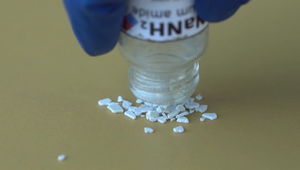Difference between revisions of "Sodium amide"
| Line 66: | Line 66: | ||
| pKb = | | pKb = | ||
| Solubility = Reacts | | Solubility = Reacts | ||
| − | | SolubleOther = Reacts with [[alcohol]]s, [[carboxylic acid]]s | + | | SolubleOther = Reacts with acyl halides, [[alcohol]]s, [[carboxylic acid]]s<br>Insoluble in hydrocarbons |
| Solubility1 = 0.004 g/100 ml | | Solubility1 = 0.004 g/100 ml | ||
| Solvent1 = ammonia | | Solvent1 = ammonia | ||
| Line 116: | Line 116: | ||
Sodium amide reacts with water to release ammonia. | Sodium amide reacts with water to release ammonia. | ||
| − | :NaNH<sub>2</sub> + H<sub>2</sub>O → NaOH + NH<sub>3</sub> | + | : NaNH<sub>2</sub> + H<sub>2</sub>O → NaOH + NH<sub>3</sub> |
Since neutralization releases ammonia, this compound can be used for completely drying wet ammonia gas. | Since neutralization releases ammonia, this compound can be used for completely drying wet ammonia gas. | ||
| Line 129: | Line 129: | ||
Sodium amide is commonly prepared by reacting [[sodium]] metal with [[ammonia]], in the presence of a catalyst, such as [[iron(III) nitrate]]. The reaction is fastest at the boiling point of the ammonia, −33 °C. | Sodium amide is commonly prepared by reacting [[sodium]] metal with [[ammonia]], in the presence of a catalyst, such as [[iron(III) nitrate]]. The reaction is fastest at the boiling point of the ammonia, −33 °C. | ||
| − | :Na + NH<sub>3</sub> → NaNH<sub>2</sub> + ½ H<sub>2</sub> | + | : Na + NH<sub>3</sub> → NaNH<sub>2</sub> + ½ H<sub>2</sub> |
A good synthesis procedure can be found [http://www.orgsyn.org/demo.aspx?prep=cv3p0778 here]. | A good synthesis procedure can be found [http://www.orgsyn.org/demo.aspx?prep=cv3p0778 here]. | ||
Revision as of 21:26, 29 August 2020
 Sodium amide flakes
| |
| Names | |
|---|---|
| IUPAC names
Sodium amide
Sodium azamide | |
| Other names
Sodamide
| |
| Properties | |
| NaNH2 | |
| Molar mass | 39.01 g/mol |
| Appearance | White or grayish solid |
| Odor | Odorless (pure) Ammonia-like (in moist air) |
| Density | 1.39 g/cm3 (20 °C) |
| Melting point | 210 °C (410 °F; 483 K) |
| Boiling point | 400 °C (752 °F; 673 K) |
| Reacts | |
| Solubility | Reacts with acyl halides, alcohols, carboxylic acids Insoluble in hydrocarbons |
| Solubility in ammonia | 0.004 g/100 ml |
| Acidity (pKa) | 38 |
| Thermochemistry | |
| Std molar
entropy (S |
76.9 J·mol-1·K-1 |
| Std enthalpy of
formation (ΔfH |
-118.8 kJ/mol |
| Hazards | |
| Safety data sheet | Sigma-Aldrich |
| Flash point | 4.44 °C (39.99 °F; 277.59 K) |
| Related compounds | |
| Related compounds
|
Ammonia |
| Except where otherwise noted, data are given for materials in their standard state (at 25 °C [77 °F], 100 kPa). | |
| Infobox references | |
Sodium amide or sodamide is an inorganic compound with the formula NaNH2.
Contents
Properties
Chemical
Sodium amide reacts with water to release ammonia.
- NaNH2 + H2O → NaOH + NH3
Since neutralization releases ammonia, this compound can be used for completely drying wet ammonia gas.
Physical
Sodium amide is a white or gray solid, which reacts violently with water. It is slightly soluble in liq. ammonia.
Availability
Sodium amide is sold by chemical suppliers, though it's almost impossible for the amateur chemist to get hold of it.
Preparation
Sodium amide is commonly prepared by reacting sodium metal with ammonia, in the presence of a catalyst, such as iron(III) nitrate. The reaction is fastest at the boiling point of the ammonia, −33 °C.
- Na + NH3 → NaNH2 + ½ H2
A good synthesis procedure can be found here.
Projects
- Reduce organic compounds
- Dry ammonia
- Dehydrohalogenation of halocarbons
- Cyclization reactions
- Ethylene oxide synthesis
Handling
Safety
Sodium amide is corrosive and reacts violently with water, releasing ammonia gas, which is irritant and toxic.
Storage
Sodium amide should be stored in air-tight containers, like Schlenk flasks, under inert gas, like argon and absolutely away from moisture. Ampouling is the best and safest way of storing this compound, especially for long periods of time.
Prolonged contact with air will form a yellow peroxide, which is shock-sensitive and can spontaneously detonate. Sodium amide samples which are yellow or brown in color represent a serious explosion risk.
Disposal
Sodium amide can be safely neutralized by adding it in a large volume of an alcoholic solution, with small amounts of a weak acid, like acetic acid, citric acid, tartaric acid. The acid is required to neutralize the ammonia fumes, but neutralizing this compound will release lots of heat. Therefore, the neutralization solution should be cooled before using and kept cool during the said process. Do this outside.
References
Relevant Sciencemadness threads
- Articles containing unverified chemical infoboxes
- Chemical compounds
- Inorganic compounds
- Sodium compounds
- Hydrogen compounds
- Metal amides
- Reducing agents
- Bases
- Superbases
- Materials that react with water
- Air-sensitive materials
- Peroxide forming chemicals
- Things that should NOT be messed with except by professionals